Here in the United States, most people associate prayer beads with the Catholic Rosary. However, Catholics aren’t the only Christians who pray with beads. The practice is common among Eastern Orthodox Christians, and is growing in popularity among Protestant and Evangelical Christians as well. The prayer discipline is nearly as old as Christianity itself, and countless Christians have benefited from it.
Many psychologists report mental health benefits from patients who use prayer beads on a daily basis, reducing stress and anxiety levels. My own psychologist, decades ago, who was not even Catholic, recommended that I pray the rosary for at least 20-minutes every day for the sake of lowering my anxiety levels and giving me mental peace. I was suffering from PTSD and panic attacks at the time. (It’s personal, don’t ask me why.) It worked! Within a month I started noticing the effects, from spiritual to mental to physical. Spiritually, I felt more at peace with God and his plan for me, whatever it may be. Mentally, I was able to calm myself more effectively and quickly. The symptoms of PTSD and panic attacks faded away. Lastly, I noticed the physical effect of lower blood pressure and better sleep. The daily Rosary changed my life for the better. Many Christians, both Catholic and non-Catholic, have reported similar experiences, using either the rosary or some other type of prayer beads.
We can look at the use of prayer beads in two ways, both scientifically and spiritually. I prefer to see it from both angles…
From a scientific perspective, prayer beads have a meditative quality, forcing the devotee to slow down and focus on something other than his/her problems, and redirecting that focus outside of his/her self, toward an object of absolute beauty, power, love and peace. That object is none other than God himself. The feel of the beads in the hand, the repetitive prayers, the focus on God, the requirement of slowing down and letting go, which is necessary for completing the devotion, all have a soothing effect on both the mind and the body.
From a spiritual perspective, using prayer beads allows the Holy Spirit to pray through us when we don’t know what to pray for, or how we should pray. We can offer our prayer-bead devotion for a specific intention or cause, then simply go into the prayers while focusing on God himself. This time that is spent in prayerful devotion, without focusing on how to say things, allows the Holy Spirit to assist our prayers in ways that surpass our understanding (Romans 8:26-27). This draws us into a deeper relationship with God, sometimes without us even realizing it, which can have the benefit of giving us a greater sense of peace with God and his plan for us, even if we don’t know what that is.
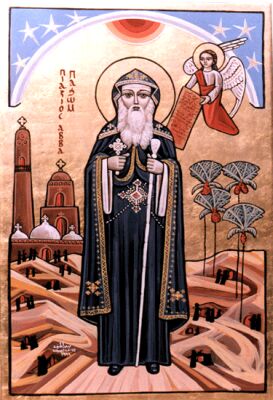
Christians began using repetitive prayer devices in Christian Egypt, during the early fourth century (between AD 300 to 350), long before Muslims forcibly took over the region, and the practice is attributed to Saint Pachomius the Great (pronounced: Pak-ho-mee-oos). According to historical record, he developed the discipline using knotted ropes for illiterate monks to use in place of reading from liturgical books, psalms and prayer manuals. The knots on the rope were used to help them accomplish a consistent number of prayers and prostrations throughout the day. Prior to the development of the knotted rope, illiterate monks would count their prayers by dropping pebbles into a bowl. The knotted rope method was far more portable and practical. The devotional lives of religious monks was/is filled with prayer constantly throughout the day and well into the night. This is in accordance with the Biblical admonition to pray without ceasing (1 Thessalonians 5:17) which Eastern-Christian monks took very seriously and literally.
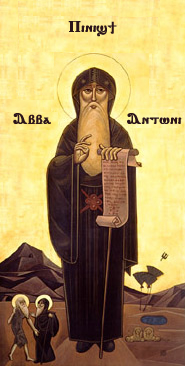
It is said that Saint Anthony the Great, a contemporary of Saint Pachomius, who also lived in Egypt, devised the method of tying the rope into tiny knots in the shape of seven crosses, overlapping each other into a larger knot that looks like a ball. The knots of Eastern Christian prayer ropes are still tied this way today.
The prayer rope devotion is fairly simple and used by Eastern Christians to this very day: among the Eastern Orthodox, Egyptian Coptic, and Eastern Catholics. Depending on the length of the rope, it can consist of 33, 50 or 100 knots. Historically, the 100-knot rope was common among Eastern monks, but shorter versions of the rope developed later as laypeople began taking up the practice. The smaller rope was for practical purposes, to easily fit into a pocket. or wrap around the wrist in a practical way. Traditionally, wearing the prayer rope around the wrist, when not in use, was the most common method of carrying it, as a constant reminder to the devotee that one should pray without ceasing. That being said; prayer ropes, prayer beads and rosaries should never be worn around the neck like jewelry. They are religious tools, not decorative fashion-statements. When not in use, they should be kept in a pocket, worn on a belt, or wrapped around the wrist. They should always be thought of as tools not jewelry. The Eastern Christian prayer rope is usually tied into a circle in the shape of a large cross, and below the cross is a tassel, which connects to the Jewish heritage of Christianity. Jews were commanded by the Mosaic Law (Torah) to wear tassels on their clothing, and Jews still practice this today with a prayer shawl called a tallit. So likewise, in memory of this ancient command to the first people of God (the Jews), Eastern Christians would tie a tassel to the end of their prayer ropes.
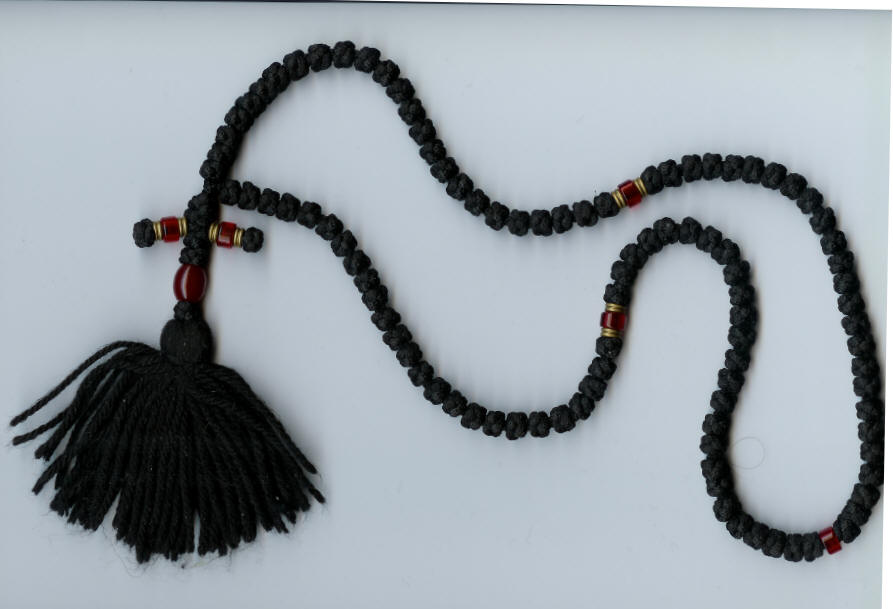
The knots themselves don’t mean anything. They are simply place markers, to help the devotee count his/her prayers, without having to think about what number he/she is on. The same is true with all prayer-bead devotions. The knots or beads have no special meaning. They’re simply used for counting, without having to mentally keep track. On the Eastern-Christian, Prayer Rope, the prayers prayed on each knot are fairly simple and repetitive. One type of devotion is the Jesus Prayer: “Lord Jesus Christ, Son of God, have mercy on me, a sinner.” This is prayed over and over again on each knot. Another type of devotion is Kyrie Eleison, which is the Greek way of simply saying “Lord, have mercy.” This too can be prayed over and over again on each knot. If you would like a short tutorial on how to do the Eastern-Christian Prayer Rope, simply click here.
Now at this point, it’s common for Western Protestants to ask “Why?” As in why do the prayers need to be repetitive? What’s the point? If we look at ancient Jewish worship, particularly as recorded in the Book of Psalms in the Bible, some of those psalms feature repetitive verses (particularly Psalm 136). The purpose of such repetition is to relax the mind and help it focus on God. The Book of Psalms is a record of the chants used in the Jewish Temple during Old Testament times. The repetitive chant of these psalms helped the Jewish people slow down and focus their minds on God.
Some Christians (particularly Biblical Fundamentalists) are under the false impression that the Bible forbids repetitive prayer, citing Matthew 6:7 as their one and only proof-text. In this verse, there is the Greek word battalogeō (βαττολογέω) means to stammer, stutter, or use the same word over and over again in a useless way that has no meaning. The King James Version (KJV) of the Bible translates this word as “vain repetitions” and Biblical Fundamentalists have used this as their singular proof-text against prayer ropes, rosaries, prayer beads, and any type of repetitious prayer. However, these same Biblical Fundamentalists fail to remember the Book of Psalms (particularly Psalm 136), which is highly repetitive, and Revelation 4:8-11 which tells us that repetitive prayer is used constantly in Heaven around the very throne of God. What these Biblical Fundamentalists don’t realize is that the King James Version (KJV), which is otherwise a pretty good Bible translation, catastrophically failed to translate this particular verse properly, and that few other English Bible translations do this. Most English Bible versions translate the Greek word battalogeō (βαττολογέω) as: babbling (NIV), empty phrases (ESV), empty phrases (RSV), talk on and on (CEV), and babble (NABRE). Obviously, this verse is in no way a prohibition against praying the same meaningful prayer repetitiously. Rather, it is a prohibition against long-winded prayers that are meant to sound flowery, sophisticated, and superior, using useless words that don’t mean much in the prayer itself, but are rather designed to impress the listeners. This understanding fits more in line with the context of the rest of the chapter (Matthew 6). This is why the ancient Eastern Christians had no problem with prayer ropes and repetitious prayer. It’s because they actually spoke Greek, read the ancient Scriptures in Greek. They knew what the word battalogeō (βαττολογέω) meant, and never in their wildest dreams would they interpret it to mean that you can’t say a short, meaningful prayer over and over again. Only modern English translators, who have a poor understanding of ancient Greek and don’t speak it fluently, would translate Matthew 6:7 so poorly. The ancient Eastern Christians would laugh at such a poor translation of the word battalogeō (βαττολογέω).
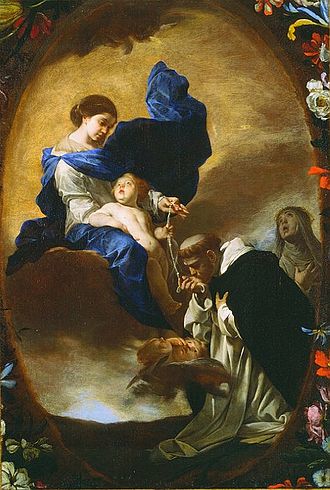
By Medieval times, the practice of using prayer ropes had spread to the Western Church as well. Gradually, knotted prayer-ropes made their way into western Europe as early as the ninth century (AD 800’s), but in AD 1214 the concept of a specific kind of beaded rope was given to Saint Dominic by an apparition of the Virgin Mary. This happened in the Monastery of Notre-Dame-de-Prouill in Languedoc, France. Though similar devotions had already been in use, St. Dominic’s vision concentrated this devotion into a very specific method.
The Rosary is a very specific and complex devotion that involves a variety of repetitive prayers. Two main figures are prayed to in the Rosary. The first is God himself, in the form of the Lord’s Prayer: “Our Father who art in heaven…” and the Gloria: “Glory be to the Father, Son and Holy Spirit…” The second person is the Blessed Virgin Mary, who is asked to pray along with the devotee, together to God, in the form of the Ave Maria: “Hail Mary, full of grace. The Lord is with thee (Luke 1:28). Blessed art thou among women and blessed is the fruit of thy womb, Jesus (Luke 1:42). Holy Mary, Mother of God, pray for us sinners now, and at the hour of our death. Amen.” The whole point of the Rosary is to include Mary in one’s prayers to God, using the prayer beads in a method of meditative prayer. Now, if you need more information about why we can ask Christians in Heaven to pray for us, just click here. The Rosary involves 15 to 20 very specific meditations on the Gospel of Jesus Christ, most of which come directly from Scripture, which devotees are supposed to announce before praying a decade of ten beads, and meditate upon during the process of praying.
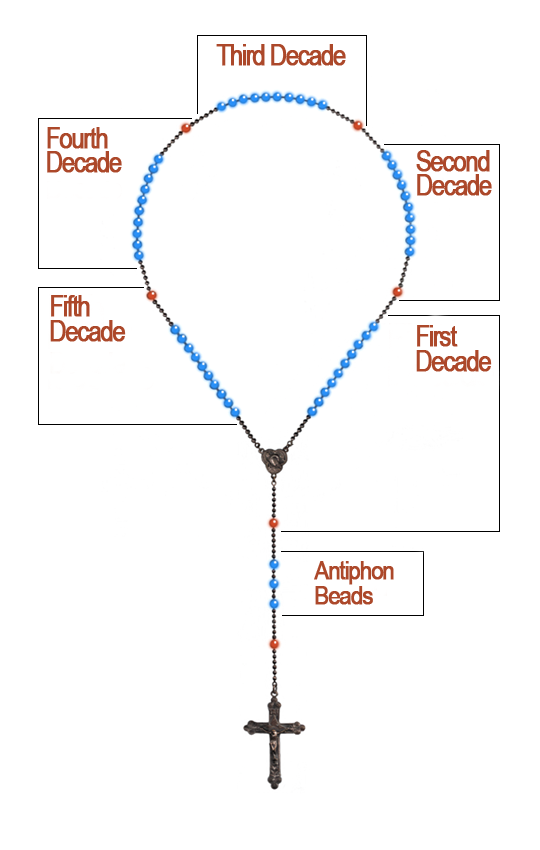
The Rosary has a very distinct arrangement of beads on a rope, chord or chain. The standard Rosary contains five decades, meaning five sets of ten beads, separated by five larger or different-color beads, each representing the five wounds of Christ while on the cross. The Rosary is tied into a circle, like the Eastern Christian Prayer Rope, with the exception of a long neck, consisting of four more beads and a cross or crucifix. Each of the five sections of meditation is called a “mystery.” Each mystery is a meditation on some aspect of the Gospel of Jesus Christ. If you would like to learn HOW TO pray on Rosary Beads, simply click here.
There are multiple ways of praying the Rosary. The Catholic way is the traditional way, which is to use the traditional prayers including the Ave Maria (“Hail Mary”). However, some Christians (particularly Protestants and Evangelicals) substitute the Ave Maria for the Jesus Prayer used in the Eastern-Christian Prayer Rope. There is nothing wrong with doing this, but most Catholics prefer the Ave Maria, which was the originally prescribed method of the Blessed Virgin Mary herself, as relayed to us by Saint Dominic. There really is no reason why the Ave Maria (Hail Mary) should be substituted, and this video explains to Protestants why it’s okay to pray the Ave Maria (Hail Mary) prayer. Still, some Protestants and Evangelicals might feel too uncomfortable with it, so they will pray the Rosary using the substitute method described above, swapping the Ave Maria prayer for the Jesus Prayer. Again, there is nothing wrong with this, it’s just not very Catholic. If you’re a Protestant, however, I suppose it doesn’t matter. What matters the most is prayer itself and allowing the repetitive prayers to calm your mind while focusing on God. I would also suppose that if you’re going to swap out the Ave Maria prayer with anything, nothing would be more appropriate than the Jesus Prayer used by Eastern Christians. It would appear that a growing number of Evangelicals are now praying the Rosary doing just this, picking up the Rosary for personal use and swapping out the Ave Maria for the Jesus Prayer. I say “more power to them” if it’s helping their prayer life.
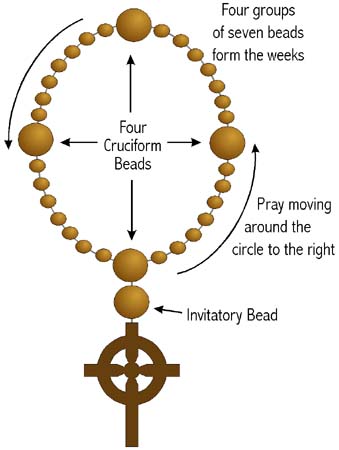
Finally, there are the Jesus Prayer Chaplet. This was developed in the 1980s by Anglicans in the spirit of the prayer-bead devotions used by Catholics and prayer-rope devotion used by Eastern Orthodox. Many Anglicans had already been using Catholic Rosaries for a long time, and some had been using Orthodox Prayer Ropes. So the idea for the Jesus Prayer Chaplet, also known as Anglican Prayer Beads, took off from that, and it quickly spread among Anglicans to Christians of other denominations as well, even among the Evangelicals, who are taking it up in larger numbers. The Jesus Prayer Chaplet devotion differs from the regular Rosary in size and arrangement. The regular Rosary has five sets of ten beads called “decades.” Whereas the Jesus Prayer Chaplet have four sets of seven beads called “weeks.” Praying one time around the circle is called a “month,” and devotees will pray one “month” for a short devotion, or three “months” for a longer devotion. There is no set devotional method for the Jesus Prayer Chaplet, and there are many devotional versions that can be found on the Internet and in books. The most common devotion is based on the Jesus Prayer Rope and can be found here. If you would like to order this arrangement of prayer beads, simply click here.
I am greatly encouraged to see our Protestant brothers and sisters taking up prayer beads and ropes as a method of deeper spiritual devotion. I think it’s important to understand that prayer is prayer. As long as it’s to God, or invoking his Saints, we’re doing the right thing. I think a lot of the stress and anxiety we feel in modern life can be attributed to a lack of devotions like these among the general population. Taking time out of the day, to do a contemplative type of devotion like this can be life changing. It was for me, and I’ve heard the same from many others. However, I think it’s even more important to consider this. God hears us when we pray. It doesn’t even matter what the prayer is. If it’s directed toward him, or one of his holy ones, he hears it. What prayer beads do, more than anything else, is they force us to actually spend time with God. They remind us that we don’t need to be eloquent in speech to talk to God, and we don’t always need to know what to say, or how to say it. What matters is that we’re simply spending that time with God in prayer.
RELATED…
Shane Schaetzel is an author of Catholic books and an Evangelical convert to the Catholic Church through Anglicanism. His articles have been featured on LifeSiteNews, The Remnant Newspaper, Forward in Christ, and Catholic Online. You can read Shane’s books at ShaneSchaetzel.Com


You must be logged in to post a comment.